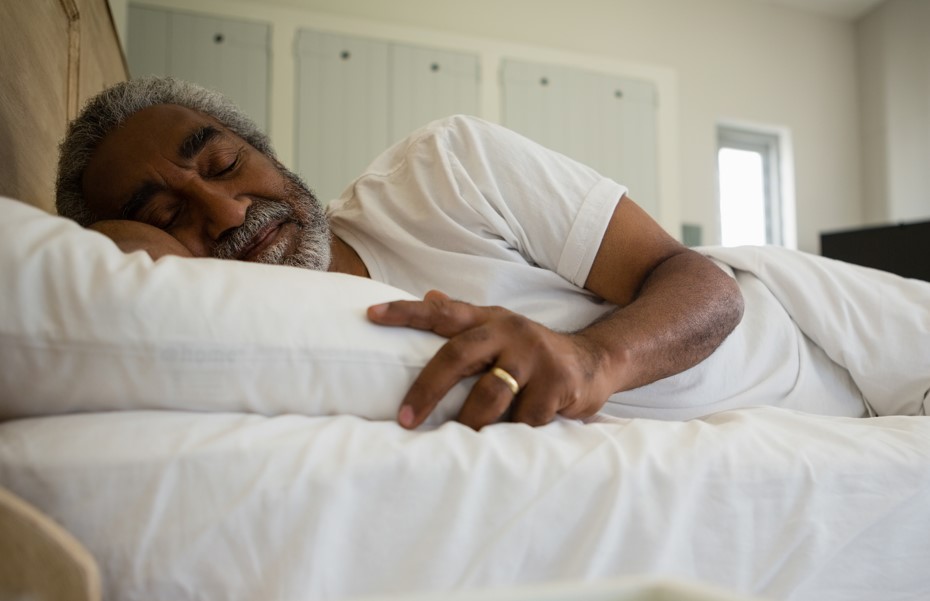In the delicate balance of golden years, sleep stands as a cornerstone for the quality of life in our seniors. The intricate interplay between stress and sleep emerges as a crucial subject, for regrettably, the struggle for restful nights is a reality faced by many seniors.

Revealing statistics indicate that approximately 50% of individuals aged 65 and older experience some form of sleep disorder, with stress playing a pivotal role in this challenge. As we navigate innovative solutions in “Dream Crafting,” our aim is not just to decode this complex relationship but to empower seniors with actionable insights for a rejuvenated and restful life.
Can a Personalized Sleep Plan Transform Your Nights?
Absolutely. A personalized sleep plan tailored to the specific needs and preferences of seniors holds transformative power in optimizing their nightly rest. By strategically addressing key aspects of sleep, individuals can experience a profound improvement in both the duration and quality of their sleep. Let’s explore the step-by-step process of implementing such a plan:
Step 1: Sleep Assessment – Building a Foundation for Transformation
Begin with a detailed sleep assessment, recording essential information such as bedtime, wake-up time, and perceived sleep quality. This initial step provides a crucial baseline for understanding current sleep patterns.
Step 2: Chronotype Consideration – Aligning Activities with Natural Rhythms
Determine the individual’s chronotype, recognizing whether they are naturally inclined towards being a morning or evening person. This insight forms the basis for aligning daily activities with their internal clock, optimizing alertness and promoting better sleep.
Step 3: Bedtime Rituals – Creating Consistency for Nightly Transformation
Identify relaxing activities that resonate with individual preferences, whether it’s reading, stretching, or mindfulness. Implement these bedtime rituals consistently to signal the body that it’s time to transition into a restful state.
Step 4: Sleep Environment Optimization – Crafting a Tranquil Haven
Evaluate and adjust factors in the sleep environment, such as lighting, noise levels, and room temperature, to create an ideal setting for rest. Investing in comfortable bedding further contributes to a physically inviting sleep space.
Step 5: Technology Management – Reducing Distractions for True Transformation
Set a technology curfew to minimize exposure to screens before bedtime, a practice known to interfere with melatonin production. Designate the bedroom as a tech-free zone to eliminate potential distractions and create a serene sleep environment.
The Transformation Unveiled – Benefits Beyond the Night
Enhanced Sleep Quality: By systematically addressing sleep patterns, aligning activities with chronotype, implementing consistent bedtime rituals, optimizing the sleep environment, and reducing screen time, seniors can experience a significant improvement in the overall quality of their sleep.
Improved Daytime Functioning: The cumulative effect of these personalized strategies is heightened daytime alertness, cognitive function, and an improved sense of well-being.
Reduced Sleep Medication Dependency: Personalized sleep plans often result in seniors relying less on sleep medications, promoting a more natural and sustainable sleep cycle.
In essence, the journey to transforming nights for seniors begins with understanding their unique sleep needs and crafting a personalized plan that caters to those specific requirements. The path to restful nights is paved with thoughtful considerations and individualized strategies.

How Can Mindfulness Techniques Improve Senior Sleep?
In the realm of senior sleep enhancement, mindfulness techniques, such as meditation and relaxation exercises, wield transformative potential. These practices, rooted in ancient wisdom, center around cultivating heightened awareness and redirecting focus from daily stressors to the present moment. Let’s unravel the intricacies of how mindfulness becomes a powerful ally in the quest for improved senior sleep.
Mindfulness Meditation: Cultivating Present Awareness
Mindfulness meditation involves immersing oneself in the present moment through techniques like breath awareness or body scan meditation. This practice is not merely about emptying the mind but actively directing attention to the current experience.
Implementation Strategies:
- Seniors can start with brief sessions, gradually increasing duration.
- Alternate methods include focusing on sensations, sounds, or visualizing calming scenes.
Progressive Muscle Relaxation (PMR): Unwinding the Tensions
PMR, a relaxation technique, guides seniors to systematically tense and then release muscle groups. The goal is to induce physical and mental relaxation, alleviating tension that may hinder sleep.
Implementation Strategies:
- Tailor the routine to individual preferences, starting with major muscle groups.
- Explore alternative methods, like visualization or guided imagery.
Establishing a Consistent Practice: Training the Mind for Serenity
Consistency is paramount in integrating mindfulness into sleep routines. Regular practice trains the mind to navigate away from intrusive thoughts, fostering a more serene mental state conducive to sleep.
Implementation Strategies:
- Initiate with short sessions, gradually extending as comfort allows.
- Encourage the incorporation of mindfulness into daily activities, enhancing overall awareness.
Mindful Breathing Techniques: Harnessing Breath for Calm
Techniques like diaphragmatic breathing or the 4-7-8 breath involve deliberate, controlled breathing patterns to induce a state of calm. Mindful breathing activates the parasympathetic nervous system, promoting relaxation.
Implementation Strategies:
- Experiment with various breath patterns to find what feels most calming.
- Encourage slow, deep breaths and provide guidance on maintaining focus.
Adapting to Individual Needs: Customizing Mindfulness for All
Mindfulness techniques are adaptable, allowing seniors to choose practices that align with their comfort levels and preferences. This inclusivity ensures that individuals can engage in mindfulness in a way that suits their unique needs.
Implementation Strategies:
- Offer a variety of practices, accommodating physical abilities.
- Encourage modifications based on individual comfort, making mindfulness accessible to all.
Addressing Cognitive Stressors: Redirecting Focus for Peace
Mindfulness aids in redirecting attention away from anxious or intrusive thoughts, providing a cognitive reprieve for seniors. Regular practice has been associated with changes in neural pathways related to attention and emotional regulation.
Implementation Strategies:
- Guide seniors in acknowledging and gently redirecting intrusive thoughts.
- Introduce mindfulness-based cognitive strategies to enhance stress resilience.
Mindfulness techniques offer a nuanced and scientifically-supported avenue for improving sleep. Understanding these practices allows seniors to make informed decisions about incorporating mindfulness into their sleep strategies, potentially paving the way for more restful nights and enhanced overall well-being.
How can the practice of mindfulness meditation be adapted to the physical or health limitations that some seniors may experience?
Adapting mindfulness to physical limitations involves exploring alternative meditation postures, such as seated or reclined positions. Mindfulness exercises can also be customized, focusing on breath awareness or guided imagery that aligns with individual comfort levels. In cases of health concerns, consultation with healthcare professionals is advised to ensure mindfulness practices are safe and beneficial.
What scientific evidence supports the claim that mindfulness can reduce reliance on sleep medications for seniors?
Numerous studies, including meta-analyses, have demonstrated the efficacy of mindfulness interventions in improving sleep quality and reducing insomnia symptoms. The underlying mechanisms involve neurobiological changes, including alterations in brainwave patterns and the activation of the parasympathetic nervous system. These changes contribute to a decreased dependence on sleep medications among seniors engaging in regular mindfulness practices.
Are there specific mindfulness techniques recommended for seniors with cognitive issues, such as dementia or Alzheimer’s disease?
Tailoring mindfulness for seniors with cognitive issues involves simplified techniques, focusing on sensory experiences and repetitive actions. Mindfulness-based interventions, adapted for cognitive impairment, have shown potential in reducing agitation and improving sleep patterns. However, close monitoring and adjustments may be necessary based on the individual’s cognitive abilities and progression of the condition.
How rapidly can seniors expect to see tangible improvements in sleep quality after incorporating mindfulness into their routines?
The timeframe for observing improvements varies among individuals. While some seniors may experience immediate benefits, such as reduced stress and improved relaxation, long-term changes in sleep patterns often emerge with consistent practice over several weeks. The neuroplasticity associated with mindfulness requires time to establish new neural pathways and habits conducive to better sleep.
Can mindfulness-based cognitive strategies be integrated into the daily lives of seniors to enhance stress resilience beyond formal meditation sessions?
Yes, mindfulness-based cognitive strategies, such as awareness of thought patterns and non-judgmental acceptance, can be integrated into daily activities. Seniors can apply mindfulness principles during routine tasks, promoting a heightened state of awareness. The development of mindfulness habits outside formal sessions contributes to sustained stress resilience, positively impacting overall mental well-being and, consequently, sleep quality.

Exploring the Impact of Nutrition on Senior Sleep Health: Insights into Dietary Choices for Enhanced Rest
In the pursuit of optimizing sleep health for seniors, the role of nutrition emerges as a pivotal factor that extends beyond mere sustenance. Scientific inquiry into the intricate interplay between dietary choices and sleep quality has revealed compelling connections, offering valuable insights for those seeking enhanced rest during their golden years.
Nutritional Foundations for Quality Sleep: Understanding the Biochemical Dynamics
Key Nutrients and Sleep Regulation:
Essential nutrients, such as tryptophan, magnesium, and B vitamins, play crucial roles in the synthesis of neurotransmitters like serotonin and melatonin, pivotal in regulating sleep-wake cycles.
Application: Encouraging diets rich in these nutrients, encompassing sources like turkey, nuts, seeds, and leafy greens, can contribute to the biochemical foundation for improved sleep.
Impact of Macronutrients on Sleep Architecture:
The balance of macronutrients, including carbohydrates, proteins, and fats, influences the release of hormones like insulin and cortisol, impacting sleep architecture and overall sleep quality.
Application: Tailoring diets to include complex carbohydrates, lean proteins, and healthy fats fosters a more stable hormonal environment conducive to restful sleep.
Dietary Strategies for Senior Sleep Enhancement: Practical Applications
Chrononutrition: Aligning Eating Patterns with Circadian Rhythms:
Chrononutrition emphasizes syncing meal timing with the body’s circadian rhythms, optimizing nutrient utilization and promoting wakefulness during the day and restfulness at night.
Application: Encouraging seniors to have a substantial breakfast and lunch, followed by a lighter dinner, supports the circadian regulation of metabolism and sleep-wake cycles.
Caffeine and Its Temporal Considerations:
Caffeine, a well-known stimulant, can disrupt sleep patterns if consumed too close to bedtime. Its half-life varies among individuals, necessitating a personalized approach to caffeine intake timing.
Application: Advising seniors to limit caffeine consumption in the late afternoon and evening, recognizing their individual sensitivity, contributes to minimizing potential sleep disturbances.
Individualized Approaches to Nutritional Interventions: Tailoring Recommendations for Seniors
Considering Individual Dietary Preferences and Restrictions:
Each senior’s nutritional needs and preferences are unique, influenced by factors such as cultural background, medical conditions, and personal tastes.
Application: Customizing nutritional recommendations based on individual preferences ensures adherence and addresses any dietary restrictions, promoting sustainable changes that positively impact sleep.
Consultation with Healthcare Professionals:
Certain medical conditions or medications may influence the nutritional requirements of seniors and impact sleep health. Consulting healthcare professionals becomes crucial for a holistic understanding of individual needs.
Application: Encouraging seniors to consult with healthcare providers for personalized nutritional guidance ensures considerations for specific health conditions and facilitates tailored sleep interventions.
In summary, delving into the nexus of nutrition and senior sleep health requires a nuanced understanding of biochemical interactions, practical applications of dietary strategies, and a commitment to individualized approaches. By assimilating these insights into lifestyle choices, seniors can cultivate a nutritional foundation that not only supports overall well-being but also serves as a cornerstone for enhanced and rejuvenating sleep.

Is Your Sleep Environment Sabotaging Your Rest? Tips for Seniors
Embarking on a journey toward restful nights for seniors involves a meticulous examination of the sleep environment, as its impact on sleep quality is profound. Unraveling the nuances of an ideal sleep space unveils actionable strategies tailored to enhance the restorative nature of sleep for the senior demographic.
1. Temperature and Lighting: Crafting a Sleep-Friendly Ambiance
Technical Insight: Maintaining an optimal room temperature, typically between 60-67°F (15-20°C), facilitates the body’s natural thermoregulation for sleep. Additionally, exposure to natural or dim light during the day and minimizing artificial light in the evening aligns with circadian rhythms, promoting melatonin production.
Practical Tips:
- Adjust room temperature using blankets or fans to suit individual preferences.
- Incorporate blackout curtains to minimize external light sources during nighttime.
- Comfortable Bedding and Sleep Posture: Essential Components of Rest
Technical Insight: The choice of mattress and pillows significantly impacts spinal alignment and pressure points. Seniors, who may be prone to musculoskeletal issues, benefit from bedding that supports their unique needs.
Practical Tips:
- Invest in a mattress and pillows that cater to individual comfort preferences.
- Experiment with various sleep postures to find the most ergonomic and pain-relieving positions.
- Noise Control: Establishing a Serene Sleep Sanctuary
Technical Insight: Noise disturbances can fragment sleep cycles and negatively impact sleep quality. Creating a quiet sleep environment is particularly crucial for seniors who may be more sensitive to disruptions.
Practical Tips:
- Use white noise machines or earplugs to drown out disruptive sounds.
- Consider implementing soft, calming background music or nature sounds if complete silence is unsettling.
- Organization and Decluttering: Streamlining the Sleep Space
A clutter-free environment fosters a sense of tranquility and reduces visual stimuli that might interfere with relaxation. A well-organized space promotes a calm mental state conducive to sleep.
Practical Tips:
- Declutter the sleep area by removing unnecessary items and organizing belongings.
- Ensure that the sleep space is dedicated solely to rest, minimizing work-related or stimulating activities.
- Technology Management: Minimizing Digital Distractions
Exposure to screens emitting blue light before bedtime can suppress melatonin production, disrupting the natural sleep-wake cycle. Seniors benefit from minimizing technology use in the hour leading up to sleep.
Practical Tips:
- Establish a technology curfew, avoiding screens at least an hour before bedtime.
- Create a designated tech-free zone in the bedroom to promote a serene sleep environment.
- Establishing Consistent Sleep Rituals: Cueing the Body for Rest
Consistent pre-sleep rituals signal the body that it’s time to wind down, facilitating the transition from wakefulness to sleep. This is particularly beneficial for seniors aiming to establish a reliable sleep routine.
Practical Tips:
- Engage in calming activities before bedtime, such as reading, gentle stretching, or mindfulness.
- Adhere to a consistent sleep schedule, aligning bedtime and wake-up time even on weekends.
- Personalized Sleep Space: Tailoring the Environment to Individual Needs
Recognizing that individual preferences vary, customization is key to optimizing the sleep environment for seniors. Personalized adjustments consider factors like preferred lighting, room aesthetics, and sensory comfort.
Practical Tips:
- Encourage seniors to express their preferences regarding room aesthetics and ambiance.
- Integrate personal touches, such as favorite colors or comforting scents, to create a uniquely inviting sleep space.
Connecting the Dots: Stress, Socializing, and Sleep for Seniors
In the intricate tapestry of senior well-being, the threads of stress, social connections, and sleep are tightly interwoven. Picture stress as a mischievous puppeteer, affecting social bonds and orchestrating a delicate dance with sleep. Here’s a snapshot of this interconnected narrative:
- Stress as the Master Puppeteer:
Stress, with its sly antics, influences sleep patterns and social interactions. It’s the maestro of the symphony, setting the tone for the entire performance.
Actionable Wisdom:
Acknowledge stressors and consider mindfulness or relaxation techniques as the ultimate puppet-whisperers.
- Socializing as the Dance Partner:
Social connections act as graceful dance partners, influencing stress levels and creating a rhythm that resonates through the night.
Actionable Wisdom:
Prioritize social interactions to sway stress away and embrace the joyous waltz of shared moments.
- Sleep as the Grand Finale:
The quality of the grand finale, aka sleep, is intricately linked to the harmony between stress management and social engagement.
Actionable Wisdom:
Cultivate a bedtime routine that embraces relaxation and values the communal bonds forged during the day.
In this captivating tale, seniors can find the power to influence the plot. By recognizing stress as the puppeteer, cherishing social connections as dance partners, and ensuring sleep takes center stage, they can orchestrate a symphony of well-being, where each note contributes to a restful and fulfilling crescendo.

Crafting Bedtime Rituals: How Habits Impact Senior Sleep
Picture these rituals as the architects of a serene dreamscape, each habit intricately influencing the quality of the night’s rest. Here’s a glimpse into the craftsmanship of bedtime rituals and their profound impact on senior sleep:
1. The Prelude: Setting the Stage for Sleep
The moments leading up to bedtime form the prelude to a restful night. Rituals during this phase cue the mind and body that it’s time to transition into the gentle embrace of sleep.
Tips:
- Engage in calming activities like reading a favorite book or practicing mindfulness to signal the approaching bedtime serenity.
- The Unveiling: Unraveling the Day’s Layers
Insight: Bedtime rituals act as gentle unravelers, peeling away the layers of the day’s stress and tension. They allow seniors to step out of the bustling daytime attire and into the soothing garments of tranquility.
Tips:
- Encourage practices such as journaling or reflecting on positive moments to unwind the threads of daily stress.
- The Rhythm: Creating a Symphony of Serenity
Consistency is the rhythmic heartbeat of bedtime rituals. Establishing a predictable cadence reassures the mind, creating a symphony of serenity that harmonizes with the natural sleep-wake cycles.
Tips:
- Craft a consistent bedtime routine, ensuring each ritual follows a sequential melody leading towards the crescendo of sleep.
- The Sanctuary: Transforming the Sleep Space
Bedtime rituals extend beyond personal actions to encompass the sleep environment. Transforming the bedroom into a sanctuary of comfort and calm amplifies the impact of these nightly ceremonies.
Tips:
- Invest in cozy bedding, dim the lights, and declutter the sleep space to create an inviting haven for rest.
- The Finale: Embracing the Transition to Dreams
The final moments before sleep are a delicate transition. Bedtime rituals form the concluding notes of the night’s symphony, guiding seniors into the realm of dreams with a gentle embrace.
Tips:
- Conclude the bedtime routine with a soothing activity, whether it’s gentle stretching, deep breathing, or a moment of gratitude.
In this enchanting narrative of bedtime rituals, seniors can become the authors of their sleep stories. By recognizing the significance of these habits, crafting a personalized bedtime symphony, and embracing the tranquility they offer, seniors can embark on a nightly journey where the artistry of sleep becomes a masterpiece of rest and rejuvenation.
Breaking the Tech-Insomnia Cycle: Seniors and Screen Time
In the digital age, where screens illuminate our lives, seniors often find themselves entangled in the web of technology, inadvertently contributing to sleep disturbances. Breaking the tech-insomnia cycle requires a nuanced understanding of how screen time impacts senior sleep and implementing practical strategies to reclaim restful nights.
Understanding the Impact:
Extended screen time, especially in the evening, exposes seniors to the stimulating effects of blue light, suppressing melatonin production and disrupting circadian rhythms. This interference can lead to difficulty falling asleep, fragmented sleep patterns, and a compromised quality of rest.
Practical Strategies to Reclaim Sleep:
- Establishing Tech-Free Zones: Designate specific areas, especially the bedroom, as tech-free zones to create a conducive sleep environment.
- Setting Technology Curfews: Introduce technology curfews, limiting screen use at least an hour before bedtime to allow the brain to transition into sleep mode.
- Embracing Night Mode: Enable night mode or blue light filters on devices during the evening to minimize the impact of stimulating light on melatonin levels.
- Prioritizing Wind-Down Activities: Encourage seniors to replace screen time with calming activities before bed, such as reading a physical book or practicing relaxation exercises.
- Exploring Sleep-Friendly Apps: If technology use is inevitable, explore sleep-friendly apps that promote relaxation, meditation, or gentle sleep-inducing sounds.
Reclaiming Rest:
Breaking the tech-insomnia cycle is about empowering seniors to regain control over their sleep health in a technology-driven world. By fostering awareness, implementing practical adjustments, and prioritizing sleep-friendly habits, seniors can unravel the intertwining threads of technology and insomnia, paving the way for rejuvenating nights and improved overall well-being.
Senior Sleep Q&A: Answering Common Concerns and Queries
Is there a specific age-related impact on the effectiveness of mindfulness techniques for improving senior sleep?
While the benefits of mindfulness are generally applicable, individual responses may vary. Seniors of all ages can explore and adapt mindfulness techniques to suit their comfort and preferences.
How can seniors with existing health conditions, such as arthritis or chronic pain, tailor their bedtime rituals to ensure optimal comfort?
Seniors with health conditions can customize bedtime rituals by choosing suitable activities and investing in bedding that provides support for specific needs.
Are there any potential drawbacks or side effects associated with implementing technology curfews, especially if seniors use devices for essential activities?
Balancing essential technology use with sleep considerations is crucial. Seniors can explore adjustments, such as using night mode, to mitigate potential drawbacks and promote a healthier relationship with technology.
Is it necessary for seniors to follow a strict bedtime routine, or can flexibility be maintained while still ensuring good sleep hygiene?
Flexibility is key. While consistency aids sleep, seniors can adapt bedtime rituals to accommodate changing circumstances, ensuring a balance between routine and adaptability.
Are there any potential interactions between sleep-friendly dietary choices and medications commonly taken by seniors?
Seniors should consult healthcare professionals regarding potential interactions between sleep-friendly diets and medications. Adjustments can be made to dietary choices based on individual health needs.





